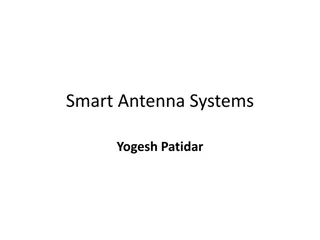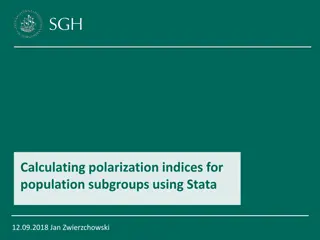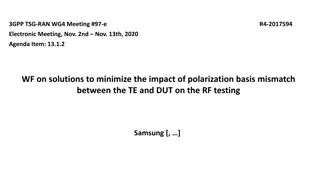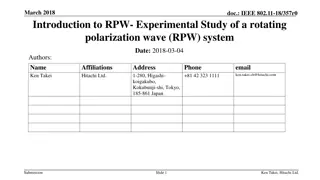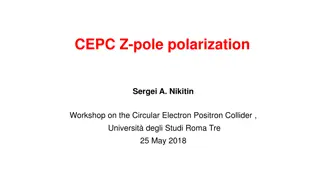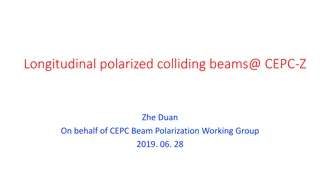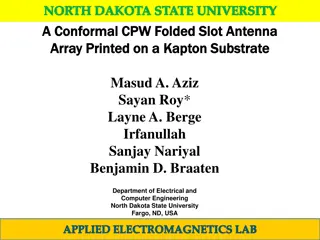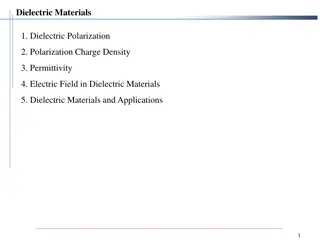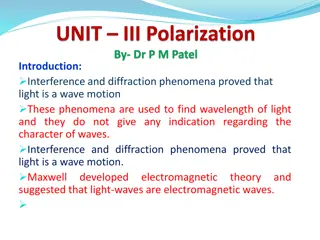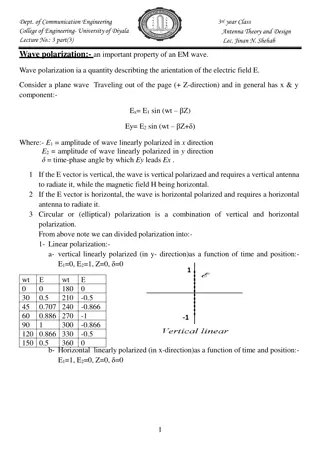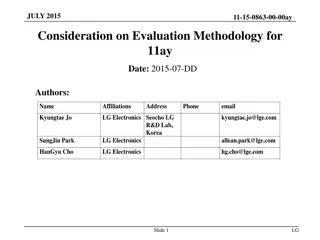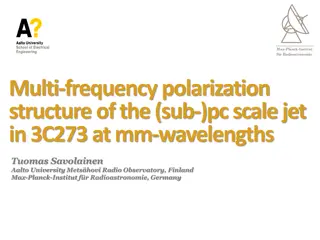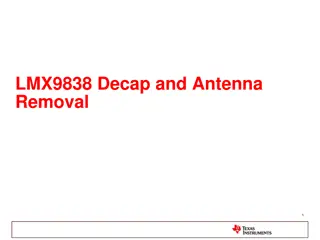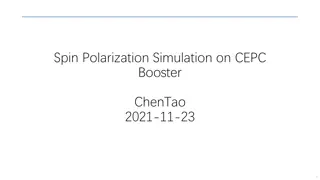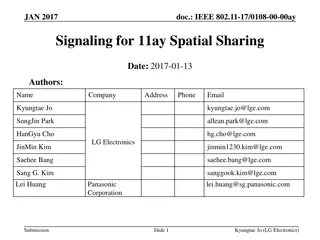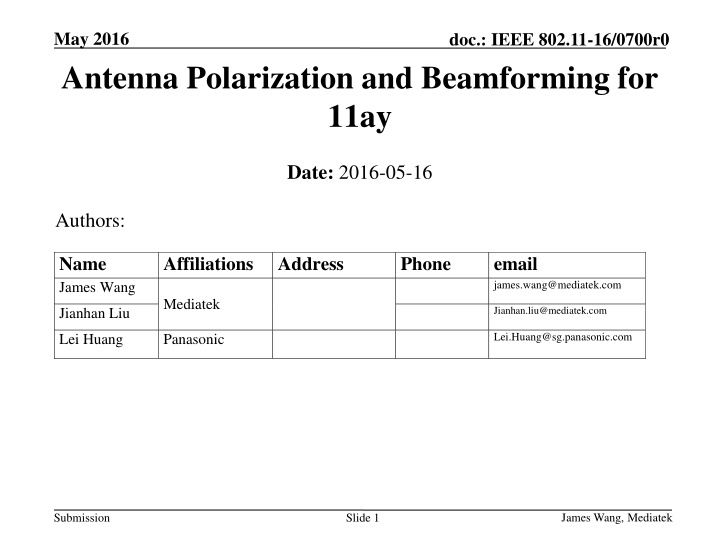
Antenna Polarization and Beamforming for IEEE 802.11ay: Insights and Implementations
Explore the importance of antenna polarization in beamforming for IEEE 802.11ay technology, focusing on techniques to optimize performance and reliability through polarization diversity and MIMO, with examples of polarization implementations and training methods.
Download Presentation

Please find below an Image/Link to download the presentation.
The content on the website is provided AS IS for your information and personal use only. It may not be sold, licensed, or shared on other websites without obtaining consent from the author. If you encounter any issues during the download, it is possible that the publisher has removed the file from their server.
You are allowed to download the files provided on this website for personal or commercial use, subject to the condition that they are used lawfully. All files are the property of their respective owners.
The content on the website is provided AS IS for your information and personal use only. It may not be sold, licensed, or shared on other websites without obtaining consent from the author.
E N D
Presentation Transcript
May 2016 Antenna Polarization and Beamforming for 11ay doc.: IEEE 802.11-16/0700r0 Date: 2016-05-16 Authors: Name James Wang Affiliations Address Phone email james.wang@mediatek.com Mediatek Jianhan.liu@mediatek.com Jianhan Liu Lei.Huang@sg.panasonic.com Lei Huang Panasonic James Wang, Mediatek Submission Slide 1
May 2016 doc.: IEEE 802.11-16/0700r0 Introduction Multiple antenna polarizations is an attractive way for small devices with limited space to realize diversity and MIMO Due to propagation characteristics of mmWave, antenna polarization can affect the performance significantly if polarization is misaligned, it affecting end-to-end performance significantly (i.e., signal drops due to polarization misalignment, cross-polarization interference rises) Antenna polarization can support MIMO spatial multiplexing. 11ay should adopt more powerful and efficient method to deal with the effects of polarization for ensuring reliable performance Potential simplification in BF training for antenna polarization by exploiting the high correlation between the ray-tracing path of the multiple polarizations James Wang, Mediatek Submission 2
May 2016 doc.: IEEE 802.11-16/0700r0 Basic Types of Antenna Polarization Types of antenna polarization Linear polarization Circular polarization Mixed polarization There are three possible orthogonal polarizations (e.g, x, y, z directions) In general, the polarization direction is described by unit vector or euler angle ( , , ) relative to a coordinate system Depending on antenna axial ratio, orientation, and propagation, the cross-polarization alignment loss (provided in backup charts) can be significant. i James Wang, Mediatek Submission 3
May 2016 doc.: IEEE 802.11-16/0700r0 Polarization Implementations Two types of polarization implementation Separate antennas for different polarizations (e.g., one antenna vertical, one antenna horizontal) Same antenna with multiple polarizations (e.g., one physical antenna with multiple polarization ports) In general, the former type can be treated as separate antennas The latter type can also be used to synthesize different antenna polarization: Polarization rotation (i.e. to change angle of inclination for TX/RX polarization alignment) Linear to circular polarization conversion or vice versa Inclined Linear ( 1= 2 G1/G2) or Circular ( 1= 2 +/-90 deg, G1=G2) 1 G1 2 G2 James Wang, Mediatek Submission 4
May 2016 Example Antenna Polarization BF Training doc.: IEEE 802.11-16/0700r0 As a first step, antenna type and capability needs to be known to both sides. TX polarization BF training can be simplified by Step 0: Indicate antenna polarization type/capability during initial Capability Exchange Step 1: complete SLS with one of the polarization or with synthesized polarization Step 2: Feedback some selected some sectors/antennas & request specific polarization training on selected sectors/antennas Step 3: Additional training frame/fields for the Polarization training on the selected antenna sectors/antennas Step 4: feedback the final selection of sector/antenna/polarization James Wang, Mediatek Submission 5
May 2016 doc.: IEEE 802.11-16/0700r0 Example of Polarization BF Training Step 1 transmitter uses synthesized circular polarization to train a linear polarization receiver Note circular polarization allows a linear polarized receiver to receive (3dB loss) without antenna alignment Step 3 transmitter trains its linear polarization inclination Align linear polarization to enhance SNR TX Step 1 Step 3 RX James Wang, Mediatek Submission 6
May 2016 doc.: IEEE 802.11-16/0700r0 Polarization Type/Capability Antenna polarization capability information to be considered Basic polarization types linear, circular, mixed Polarization switch Polarization MIMO Synthesizable polarization linear (adjustable inclination) circular (RH, LH) mixed polarization (RH, LH, adjustable inclination & eccentricity)) James Wang, Mediatek Submission 7
May 2016 doc.: IEEE 802.11-16/0700r0 Conclusions 11ay should enable more powerful and efficient method to deal with antenna polarization for enhanced performance Propose, as a first step, to explicitly exchange information about antenna polarization types/capability Allowing both sides to know the polarization type/capability Enabling further development of more efficient or powerful BF Training protocol for antenna polarizations James Wang, Mediatek Submission 8
May 2016 doc.: IEEE 802.11-16/0700r0 Straw Poll 1 Move to include the antenna polarization capability information in the 11ay capability exchange. (Capability information is TBD) Yes No Abstain James Wang, Mediatek Submission 9
May 2016 doc.: IEEE 802.11-16/0700r0 Backup Charts James Wang, Mediatek Submission 10
May 2016 doc.: IEEE 802.11-16/0700r0 Polarization Misalignment The received power is affected by the misalignment in TX and RX antenna polarization, if only single polarization is used in TX and/or RX. Received power loss due to misalignment of the two linear polarizations: i i rx = tx where i is the tx unit vector and i is the rx unit vector tx rx Received power loss due to misalignment one linear polarization and one circular polarization 1 = tx i i rx 2 where i is the tx unit vector and i is the unit vector of tx rx the antenna polarizati on Note that SIMO or MIMO RX with dual polarization will not have misalignment loss. James Wang, Mediatek Submission 11
May 2016 doc.: IEEE 802.11-16/0700r0 Polarization Misalignment Received power loss due to misalignment of the two circular polarizations: 2 ( 2 2 i i Sgn tx + = 2 ) 1 rx 4 1 . 1 . where Sgn is if co pol and if cross pol Received power loss due to misalignment of the two elliptical polarizations: 2 + + ) 1 2 tx 2 rx 2 2 rx 1 2 + 2 ( + i i tx rx = tx 2 tx 2 rx 1 ( )( 1 ) , where i is + the unit tx vector and i is the rx unit vector of antenna polarizati on tx rx = ) 1 ( 1 )( , r r is the axial ratio of tx antenna in dB tx tx tx = + ) 1 ( 1 )( . r r is the axial ratio of rx antenna in dB rx rx rx James Wang, Mediatek Submission 12

